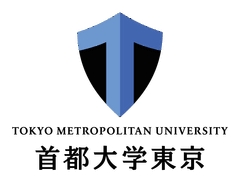 TOKYO
METROPOLITAN UNIVERSITY
TOKYO
METROPOLITAN UNIVERSITYRESEARCH INTERESTS
Cosmology Supersymmetry and Supergravity Strings and Superstrings Branes and M-Theory Conformal Field theory Non-linear Sigma-models
Motivation:
The quest for an ultimate unified theory of all fundamental physical interactions is the most prominent and important problem of modern theoretical high-energy physics. The ultimate (i.e. most fundamental) physical theory must go beyond the so-called Standard Model of elementary particles, it must include quantum gravity, and it should explain the origin of our Universe. The practical significance of the unified theory goes far beyond the high-energy physics, since it may provide the keys to many unsolved actual problems in astrophysics and condensed matter, such as physics inside black-holes, early Universe, and strong coupling. There is nothing more practical than a good theory!
The superstring theory is the leading candidate for quantum gravity and physics beyond the Standard Model. However, a perturbative vacuum in any superstring model is highly degenerate, whereas the effective physics at low energies heavily depends upon the choice of vacuum. To make contact with the Standard Model, one has to investigate non-perturbative superstring vacua.
The recently proposed M-Theory unifies all known ten-dimensional
superstring theories, as well as the eleven-dimensional supergravity. M-Theory
also has extra symmetries (called dualities) that relate weak
and strong coupling regimes. The key ingredients of M-Theory are the extended
objects called BPS branes that are essentially non-perturbative
(solitonic). Amongst the solitonic branes there are the so-called D-branes
where open superstrings can have their ends. Since the fundamental degrees
of freedom in M-Theory are unknown, this theory cannot be applied from the
first principles yet. Nevertheless, in the semi-classical approach,
some non-perturbative corrections can be captured by the BPS branes.
Some Research Projects:
[1] Our most recent research interests are related to supergravity and its applications to Cosmology. We are interested in various viable realizations of cosmological inflation in the early Universe, as well as that of Dark Energy in the present Universe, in the context of supergravity, and their relation to Particles Physics, and supersymmetry breaking, in particular.
[2] Some instanton corrections to the superstring low-energy effective action arise due to the (Euclidean) BPS branes wrapped about certain surfaces (cycles) in the compactified space (usually, a Calabi-Yau threefold). A derivation of the corresponding low-energy effective supergravity action in four or five spacetime dimensions is one of the actual problems in M-Theory. Our approach to this problem is based on the use of integrable systems and complex differential geometry.
[3] Another proposal deals with part of M-theory that is supposed to
explain how Maxwell electrodymanics is going to be generalized in
M-theory. There are strong arguments coming from M-theory that the correct
generalization of the Maxwell electrodynamics is given by some kind of
the (non-linear) abelian Born-Infeld theory. We would like to
generalize those arguments to the case of several coinciding branes where some
non-abelian Born-Infeld-type gauge theory emerges, whose leading term
is given by the standard Yang-Mills action. The Born-Infeld theory gives rise
to the famous taming of Coulomb self-energy of a point-like electric charge.
It also shares (in four dimensions) with the Maxwell theory
electric-magnetic self-duality as well as physical propagation
(no shock waves). In fact, the Born-Infeld I theory has even more magical
properties, such as the built-in upper bound for the electro-magnetic
field-strength and the existence of exact soliton-like solutions of finite
total energy. In addition, when a constant Kalb-Ramond background
B-field is turned on, the Born-Infeld theory in some limit becomes equivalent
to a non-commutative U(1) gauge field theory in flat spacetime via the
so-called Seiberg-Witten map . The supersymmetric extensions of the
abelian Born-Infeld action can be identified with the Goldstone-Maxwell
actions associated with partial (1/2) spontaneous supersymmetry
breaking, whose Goldstone fields belong to a Maxwell (vector)
supermultiplet with respect to unbroken supersymmetry. The supersymmetric
Born-Infeld actions in various dimensions also represent the worldvolume
low-energy effective actions of D-branes. We want to determine the interaction
(couplings) of the D-brane worldvolume fields to the bulk fields.
Message to the Students of all Levels:
We are looking for ambitious students who would like to join our group and
actively participate in our research projects. The eariler one begins is the
better. We particularly encourage students with independent thinking and
strong interest to applied mathematics in theoretical physics.
Our Special Message to Foreign Students:
Tokyo Metropolitan University and our group welcome applications from qualified foreign (non-japanese) students. Formal applications are accepted in January each year for the Doctor (PhD) Course, and in September and January each year for the Master (MS) Course. Written entrance exams and interviews for the MS course are held in September and February each year, interviews for the PhD Program are held in January. Students in the MS program are required to carry out a course of their study, supervised by a TMU staff member, culminating in a Master Thesis which may contain original research results. Students in the PhD Program are required to carry out a research project supervised by a TMU staff member, and to write a Doctoral Thesis which must contain original and substantial new research results.
The entrance examinations and/or interviews, as well as the entire course of study, may be carried out in English, although most of lectures and seminars are held in Japanese. Hence, some knowledge of Japanese language will be helpful for communication with other students and staff, as well as for daily life. Japanese language courses, both formal and informal, are available for foreign students. Prospective students are strongly advised to contact a TMU staff member for further advice.
Japanese Government Scholarships are the principal source of financial support for
foreign students. Information concerning the Scholarships is available from the Japanese
Embassies and their web-sites. In general, such Scholarships permit the holder to enter
Tokyo Metropolitan University as a `research student' and then prepare for the exams to enter
the Graduate School for the chosen Course.